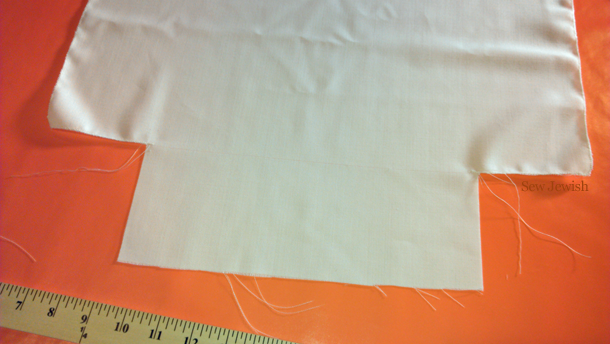 Update: You’ll now find full instructions for a tallit as well as a tallit bag, kippah, and other projects in the Sew Jewish book, available in paperback from Amazon and in PDF format directly from Sew Jewish.
Update: You’ll now find full instructions for a tallit as well as a tallit bag, kippah, and other projects in the Sew Jewish book, available in paperback from Amazon and in PDF format directly from Sew Jewish.
The tallit is the one sewing project (besides the curtains that hung in the Tabernacle and Temple and the priests’ clothing, I suppose) that arises from a Biblical commandment: the mitzvah to put tzitzit on the corners of four-cornered garments. We all know basically what a tallit looks like a rectangular garment with knotted strings on the corners. But to get it halakhically right we went back to the Code of Jewish Law, the Shulchan Aruch, and the teachings of the modern Jewish scholar Aryeh Kaplan in his book, Tzitzith.
The additional squares of colored fabric on the corners aren’t strictly necessary, so you could skip them and simply sew circles of stitches to reinforce the tzitzit holes. But I recommend including them. They help keep the tallit fabric from tearing, and they give you an excellent opportunity to personalize the prayer shawl through the material you choose.
The atarah, or neckpiece, marks the top of the tallit so that you always wear it the same way. It’s also optional, but it’s another opportunity for personalization. For this tallit, we added a purchased atarah to point out that such things exist. They give you design options and can make your life a bit easier (this one is the Jerusalem Bracha atara in slate blue from Emanuel Judaica). Another option is to make an atarah from the same fabric as the corner pieces (Update: We’ve now posted a free simple atarah pattern as well as patterns for more personalized versions in the Sew Jewish Shop).
A few words about tallit sizes
The completed size of this tallit is 64″x18″ (1.6m x 46cm), not including the fringe or tzitzit. This is a shawl-size tallit. You can use the same techniques to make a larger tallit, just starting with a larger piece of fabric.
A few words about tallit size: Aryeh Kaplan, in his book, Tzitzith, lays out the Orthodox teachings on the size of the tallit, which specifies using a large tallit rather than the shawl-size tallit specified in this project. If you want to follow the teachings for a large tallit, here are Kaplan’s specifications for the dimensions:
“A Tallith should be large enough so that one can drape it over his shoulders, with two corners in front and the other two in back. A good Tallith should therefore measure at least four feet by six feet and be large enough to cover the individual down to his waist. As an absolute minimum, it must measure one cubit or Amah (24 inches in width).”
Materials
2 yards white wool suiting. This pure wool will appear slightly off-white. (For halakhic reasons, don’t substitute linen. The Torah forbids combining linen and wool in the same garment, and the tzitzit strings available to purchase are almost always wool.) I found the wool used in this project at Mood Fabrics.
Alternative fabrics: If you can’t find wool suiting, other heavy-weight woven fabrics with coarse fibers will work with the tassel-making technique used in the instructions. Good options are heavy-weight silk and polyester broadcloth. (And thank you to the reader who wrote to ask about alternative fabrics!)
More about tallit fabrics: What kind of fabric can you use to make a tallit?
1/8 yard medium-weight blue satin
Atarah (neckpiece), pre-made or handmade [Here is a free simple atarah pattern and a more personalized pomegranate atarah pattern for purchase.]
Off-white polyester or polyester/cotton thread
Blue polyester or polyester/cotton thread
Polyester or polyester/cotton thread to match the atarah
Set of wool tzitzit, available from local Judaica shops and online
Special Equipment
Embroidery scissors or other sharp-nosed scissors
Instructions
Make the tallit pattern
Make a rectangular pattern, 71″x18″ (180cm x 46cm). You can use pattern paper, Kraft paper, wax paper, or pages from your Econ 101 notebook taped together. But don’t use anything with smudgy ink or pencil.
Make the body of the tallit
Cut one copy of the pattern from the wool fabric.
On each short end of the tallit, measure in 3½” (9cm), and remove a crosswise thread (a pin will help).

Now you’re going to remove a square of fabric from each corner. On each short end of the tallit, measure in 3 5/8″ from each corner. Use pins or a light pencil to mark a line up to the removed thread. Cut along this line, and then cut across the line of removed thread just up to the first cut.

The middle section of fabric that remains on each end of the tallit will become the decorative fringe a bit later.

With a sewing machine and using off-white thread, finish the edges of the tallit with zigzag stitches, starting and stopping about a half inch inside the fringe area.


Tip: If you’re inclined to try on the tallit, this is a good time to do it. Once you create the fringe, you’ll have a four-cornered garment that you shouldn’t put on until after you’ve added the tzitzit. (That’s the halakhah talking.)
Make the decorative fringe
Remove all the crosswise threads from the fringe areas. A pin can help. This step can be a bit fiddly, but take heart. It won’t take that long.

Use pins to mark off seven fringes, each a little more than 1½” (3.8cm) wide.

Gather the threads for each fringe, twist them together, and tie them into a knot. As you tighten the knot, make sure the tallit can lie flat, and try to position the final knot about 1″ (2.5cm) away from the body of the tallit.

Add the corner pieces
Now for the corner pieces. Make a 4½” (11.5cm) square pattern. Cut four squares from the blue satin. Using the blue thread, baste ¼” (6mm) away from the edges. Press under the edges of the fabric along the basting.

Pin the squares to the corners of the tallit, being sure to place the wrong (back) sides of the squares on the right (top) side of the tallit. (Note: If you’re making a large tallit rather than the shawl-sized tallit featured in this post, place the squares on the wrong side of the tallit.)Machine stitch the squares to the tallit, using blue for the top thread and off-white for the lower thread. Keep the stitches close to the edges of the squares.
Make the holes for the tzitzit strings
At each corner, determine the location of the hole for the tzitzit by measuring 2″ from the edges of the tallit. Be sure to measure straight across from the edges of the fabric, not diagonally from the corner. Mark the spot with a fabric marker or light pencil mark. Around this spot, draw a circle with a radius of 1/8″ (3mm).

If your sewing machine has an eyelet feature, use that to sew an eyelet around the circle. Otherwise, trace the circle with a line of close, medium-width zigzag stitches. To make the tight curves, pick up the presser foot every two to three stitches, with the needle in the fabric, and rotate the fabric. For the best results, rotate the fabric while the needle is positioned on the outer edge of the circle of zigzag stitches rather than on the inner edge of the circle. For the best control, you might want to walk the machine through the stitches (that is, turn the manual control to move the needle up and down rather than pressing the foot pedal).
Tip: If you have trouble with this free-style approach, we’ve now posted a pattern and placement guide and video for sewing the tzitzit holes.

Working from the back of the tallit, fold the fabric at the circle. Being careful not to cut any of the zigzag stitches, use embroidery scissors to snip through the layers of fabric inside the circle. You don’t need to cut away all of the fabric inside the circle. You just need enough of an opening for the tzitzit strings to get through.

Add the atarah (neckpiece)
Pin the atarah to the middle of one of the long edges.

Using thread that matches the atarah as the top thread and off-white for the lower thread, sew the atarah to the tallit, staying close to the edge of the atarah.

Affix the tzitzit strings
Tie the tzitzit to the corners using the video reference here.

Now that you’ve added the tzitzit, try on the tallit. Looks great!
Congratulations! You’ve made a beautiful tallit.
Maria Bywater is the author of Sew Jewish available from Amazon.com and in PDF format from Sew Jewish. She teaches hands-on Judaica sewing workshops.


